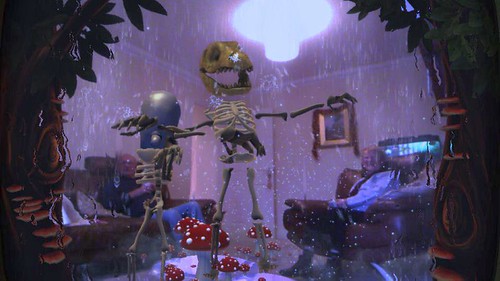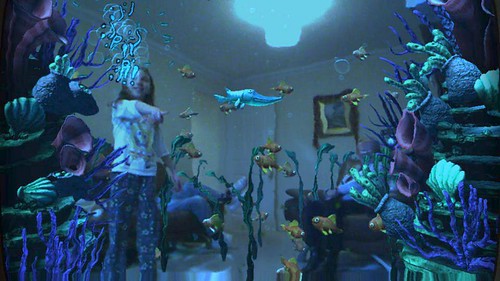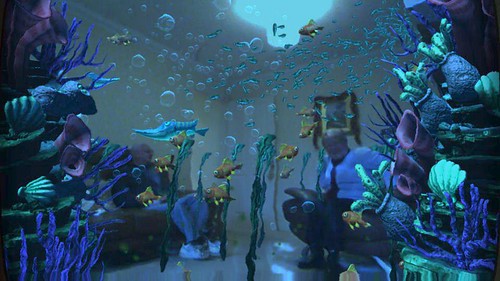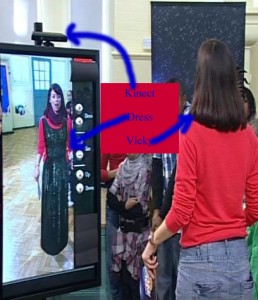Ye si know some of us of a certain web age thill think CGI is “Common Gateway Interface” and gets us this thinking in Perl and about $POST and $GET but CGI is now commonly known as Computer Generate Imagery. Thinks have certainly changed over the last few years with respect to what can actually be generated and just how good it has got.
Last night I saw the new Galaxy chocolate ad. Normally if there is some CGI my brain goes into how did they do that mode, travelling around the uncanny valley. However this ad I watched and thought wow that actress looks just like Audrey Hepburn. I did a quick google to find that it was Audrey Hepburn the CGI version. Now watching it again I can see that it is CGI, though not all the time.
The other ad doing the rounds that is obviously CGI, unless horses really can moonwalk is 3’s dancing pony. Strangely it is the real life bits that jar with me on this. The close in on what are model hooves is jarring compared to the smoothness of the rest of it.
It is nice to see 3 doing a pony dance mixer as a youtube application. It is a lot more Monty Python than slick CGI but its worth a few moments to have a go 🙂 Mine is here
What I saw today though whilst researching more about Holodecks was this great twist on the sort of building projection projects that animate entire cityscapes. Here the project canvas is a person. This is really brilliant I think. Lots of the images certainly stick with you after watching it. It works by scanning the person (who then sits very still) the scan informs the projector how to deliver and map the textures onto the surface. The same way designers use a 3d application and create a UV map of the textures and even baked lighting.
This is more blended reality at work 🙂 It is similar to how the Kinect performs some visual trickery on screen (not yet via projection but maybe soon) in things like Kinect Party
augmentedreality
Making animation easier with QUMARION
I tweeted about this the other, but after it came up in the Q&A session at yesterdays blended reality pitch I realized I had not put any more here about this interesting device.
The QUMARION is rather like the posable wooden mannequins that artist use to practice drawing figures

It is instead fully instrumented with sensors to work with a digital description of a human skeleton.
So as you pose the figure that translates to poses in the 3d modelling package.
A purist 3d designer may regard that as undermining their skills with manipulating and understanding the interface on a 2d screen. However this came up as an answer to a question about blended reality as I was talking about how sometime the technology can get in teh way, other times it disappears and lets us use what to know to enhance an experience.
The QMARION is rather like using the real guitar in Rocksmith, it may be an appropriate tool for understanding and communicating with an application.
I know that when I use 3d packages there is a barrier in having to deal with a mental translation of a 2d representation. Being able to just pose a physical device and explain what is needed physically would work for me.
A long while ago I was trying to make some tennis animations for a well known Second Life project. I found myself standing and looking in a mirror, performing the action then sitting down making that action work on a very simple digital rig, but then I had to tune it so that it looked better for the screen. I had no motion capture which would obviously have helped in the first place, but it is the extra artistic interpretation and subtle tweaks that it would have helped a great deal to have had a hands on device to help.
Now this device is only input as far as I know so there is an obvious extension in using it as an output device too. If I mocap a move, but then the device can play that back in physical steps and frames then I could tweak and enhance it. Obviously in games there are some moves that just don’t exist, you cant get certain flips and jumps happening. You can however start with a basis of what you can do.
Again of course this relates to studying the forms in Choi Kwang Do. A physical, but digitally recorded recreation may help someone even more to understand. Also a mannequin can be made to hold a position that may be a transfer on one move to another that a person bound by the law of physics cannot. It becomes a physical pause button.
Another extension to the idea is that this restricts you to one rig. A component model that lets you build any size or shape of joints to create the armature for any creation would be incredible. Combine that with the ability to 3d print the components in the first place, but them together, have that create the rigged model and then animate away. There are some fantastic opportunities for people to create interesting things as this approach evolves.
Kinect Party making you dissapear- now that’s magic
The wonderful Happy Action Theatre by Double Fine has been rebranded and given away fro free as Kinect Party. It is a very amusing set of Kinect based toys to play with plus some DLC. It sees you and hears in the room and does all sorts of collision detection games like popping a room full of balloons or Augmented reality things that add hats and gadgets to you as you bounce around your living room.
However hidden away are some really clever techniques. The Kinect is scanning the geometry of the room not just tracking the players. This means balloons bounce off your sofa, or pigeons land on tables.
The really clever bit is when as a player you are replaced. Take a look at this picture

The predlets were both in shot, but they get replaced by skeletons. The Skeletons are thinner and have more transparent bits then their human counterparts. The games using the Kinect manages to rebuild the background live behind them, removing them from the scene completely, then adding in a new character. This is not a stick on AR it is much more clever, or at least appears to be.
In another example both predlets were under water. Predlet 2.0 was dead centre of the picture, grabbed a hook and was pulled upwards on the tv screen to be replaced by an approximation of what was behind him. He is there but invisible.

Shortly afterward predlet1.0 did the same thing and voila… gone (but still in the room looking at the screen). Having obscured her Grandad previously behind her in the picture there he is, as if she was invisible.

The screen is done as an underwater scene so there is lots of wobbling of waves that would counter any odd image artefacts, but this is being done on live video on a free application on a console that is nearing the end of its run.
This puts what I wrote in Flush Magazine about the next gen Kinect and how it may deal with removing people from a scene into more context.
(not only is this game/toy clever it is really funny and a great laugh BTW 🙂 )
I hope this puts into context me spamming Facebook with Kinect Party photos, but I loved it when it was Happy Action Theatre and it has got more clever and engaging (and free).
Merry Christmas one and all, I am off to eat some mince pies.
Virtual Athletes – A journey with some tech
It was really cool today to see the brilliant next edition of Flush Magazine hitting the virtual shelves (with my 3rd article). This time on some of the virtual sports technology and a little bit of historical evolution from my personal experience. There are lots of other things to read in the mag, also available on the ipad, but my contribution is pages 92 to 97.
There are lots of ways to check this out including a great PDF download
So thats virtual sports, merged with real activity and my newly found and exciting Choi Kwang Do martial art and the Coaches Center in this issue. The previous issues have been 3d printing and virtual worlds 🙂
Huge thanks go out to @tweetthefashion for publishing these articles and the monumental effort it is for them to get the whole edition done, making them look so good and with everyones great stories and features 🙂
Finally an interesting advert – Gadget Show 360, F1, Second Screens
Last night at 9pm a very innovative ad aired for the new Gadget Show. It relied on an iOS application installed and running ready to go. At 9pm the tv promo started, the jingle ditty at the start cued the application to life to run the same promo advert. The TV was of course a fixed camera, but the app was a full 360 video. Moving the iPad around looking up down left right and behind you could follow the action, and it was perfectly synchronised to the TV advert. So as Jason dashed around the studio you could follow him.
The video was of course preloaded in the app, but it was a very impressive experience. It was a polished example of innovation using both the TV screen and the ever increasingly common iPad.
The video is available on the web here, in the same sort of way the old quicktime VR’s were back in 1998 🙂 It was the linking of the fixed TV showing what you would have seen combined with the physical activity of moving the iPad around whilst held up that made this more engaging than just a 360 video on the web.
Of course this would have been even better taken to the next level. If we were all in the studio too and were aware of one another. Think a virtual world synched to the TV broadcast. Where we have the same sort of control on out view of the system.
The second screen as it is being called is becoming very influential. It has been great being able to watch the Sky coverage of F1 both on the TV and with the app on the iPad letting me look at stats, track positions and in car driver feeds. It is an extension of us sitting here with our wireless enabled laptops, or having moved the desktop PC into the main living area (the previous wave) to be able to look things up, to follow links to add to our enjoyment of a previously passive experience.
It is all a part of blending realities with all the new forms of visualisation and and interaction hardware that we now have available to us. Why restrict us to one screen?
TV Showreel – 2011
Now that the 3rd series of Cool Stuff Collective has rotated from the ITV player there is not an easy resource available to see some of the future tech pieces that we did. It is a custom in TV land to have a showreel. So here is my second TV show reel featuring the lovely Vicky Letch and a cameo by Blowfish at the end 🙂
This is all down to all the guys and girls at Archie Productions and John Marley in particular getting this show going and trusting me to do my thing for the 38 shows we did over the past year or so.
I had to edit this up from the videos I had of the show, so it is a bit rough and ready but I am a tech g33k not a production suite guru (to continue the theme you will see if you watch all the 7 mins above 🙂
The video features arduino and open source, 3d printing with rep rap, skylanders, augmented reality, bloodhound ssc, tenori on, Kaspar and hydrogen fuel cells plus a bit of slapstick literally thrown in 🙂
Anyone who sees the conference and workshops I do will know that this all these things actually thread together to a bigger story of what the future will hold.
Augmented reality – The Cool Stuff Way
Last Friday we filmed the last in the series of Cool Stuff Collective (booooo), but there are still 3 more to air and the one currently in play (Yay!!!!).
Last Saturday’s was the one with Augmented Reality. We did some AR back in the previous series but it is such a huge subject it deserves more coverage.
I had a few things lined up to do on this but not all of them made it. I wanted to show Disney AppMates, which we had but it seemed to not work very well so I dropped it at the last moment. It turns out you have to hold the cars in just the right place which if you have small hands it works, for bigger hands it did not, until I read the manual(looked at the box). It was a pity as it is a twist on AR using a physical device on an Ipad. Never mind 🙂 what we did have was some brilliant examples from Apache that @AdamApache brought along. This were also some AR xmas cards from 3dgreetingscards
The Apache guys brought a marker based large scale driving game for the Ipad (based on the Driver poster) and a Kinect powered magic mirror that let Vicky try on some clothes.
We had a few logistical problems as this was another item where we strayed away from the table.

This quick screen has further been augmented to show the
I think it worked ok though 🙂
It’s on the ITV player for few weeks more
Blippar Marmite – Product PackARging
The Blippar application on smartphones is an interesting development in Augmented Reality. It is using markers to determine what to show and where to show it in a magic lens configuration (sticking virtual over a real view of the world with your camera/screen). However the markers are not odd looking tags but merely the unique brand images from product packaging.

In this case it it detecting Marmite and providing some overlay recipes and information. What was good was that it was not an ordinary jar of marmite but an commercial tub (I buy in bulk !)
So if it sees a logo it has in its library then it initiates the AR experience.
Of course if you see an unusual marker with other AR or even just the simple QR codes you may be inspired to reach for your phone to view it, rather like seeing a text URL and typing it in. However as this gets more prevalent, maybe always on cameras looking for content for our headsup displays on out glasses or contact lenses then that becomes less of a barrier to entry.
There is of course an odd problem with this. What you are doing is replacing and obscuring the brand logo, the very thing you recognize, with some extra digital content. I hope there will be some more clever design (rather like on the 3DS AR games where the table becomes warped and morphed) that incorporate, not just replace/overlay the marker.
Still, its a massive change from a few years ago when AR couldn’t happen easily without people having lots of screens and cameras. Now, ordinary (yet still quite pricey) devices let us explore digital layers and see information that is not usually visible.
Don’t forget though AR is not just one layer on a real environment, there is lots of scope to use the principles and invent some very clever real/virtual mashups
